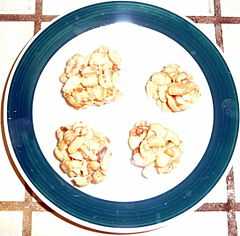Chikki
| Chikki | |
|---|---|
| Snack | |
 Home-made chikki in ball form. | |
| Place of origin: | |
| India | |
| Region or state: | |
| Gujarat | |
| Main ingredient(s): | |
| Groundnut, jaggery | |
| Recipes at Wikibooks: | |
|
| |
| Media at Wikimedia Commons: | |
|
|
Chikki is a traditional ready-to-eat Indian sweet generally made from groundnuts and jaggery.[1] There are several different varieties of chikki in addition to the most common groundnut chikki. Each chikki is named depending upon the ingredients used. Usually, ingredients such as puffed or roasted Bengal gram, sesame, puffed rice, beaten rice, and Khobara(desiccated coconut) are used.
In regions of North India, especially Uttar Pradesh and Bihar, this sweet is called Layyiya Patti, being also very popular in Brazil, where it is known as pé-de-moleque, and in Paraguay, where it is called Ka'í Ladrillo.
Ingredients

Some chikkis are made using a combination of these ingredients. Special chikkis are made out of cashews, almonds, and pistachios. Though jaggery is the usual sweetener material, sugar is used as the base in certain types of chikkis. It is a very popular sweet item in both rural and urban South Asia (spanning India, Pakistan, Bangladesh, Nepal and Sri Lanka). Some also add glucose to the chikkis, which are usual there. It just started from a single flavor of jaggery and peanuts. But today there are many different exotic flavors available in the market.
Similar preparations are made in the South Indian state of Tamil Nadu with a larger proportion of nuts to jaggery and the mixture is formed into balls rather than slabs. The most common versions are kadalai urundai (peanut balls), ellu urundai (sesame balls) and pori urundai (puffed rice balls). In Kerala, it is made in both slab and ball forms. Peanut based sweet is called as kappalandi mithai and sesame based sweet is called as ellunda.
Preparation
The preparation of chikkis is very simple and consists of first preparing the hot jaggery syrup with a minimum of water, adding nuts to the syrup to coat them (with the syrup) and then transferring the nuts to a wooden mould, then rolling them to a thickness of about 6–8 mm using a wooden roller/and we also place in to the any steel plate for cooling, cutting into slabs, and packing. In homes, smaller quantities are hand rolled with wooden rollers.
Most popular chikkis are sourced from the Indian towns of Lonavala, Matheran, Mahabaleshwar, Panchgani and Karjat near Mumbai.[2]
Pé-de-moleque

Pé-de-moleque (Portuguese: [ˈpɛ dʒi muˈlɛki]), is a traditional candy from the Brazilian cuisine made of peanuts and jaggery or molasses. The origin of its name lies in the fact that most paved streets of colonial Brazil were made by laying down various odd rocks in a loose layer of sand, and having street children stomp on them to flatten the surface. While cobblestone streets are called rua de paralelepípedos and unpaved streets rua de barro (literally, "clay street"), those made by the method described above came to be named pé-de-moleque. Since the appearance of the peanuts stuck together by molasses was found to be similar to that of these type of street, the candy took the same name.
 |
| This article is part of the series |
| Brazilian cuisine |
|---|
|
Regional cuisines
|
|
Ingredients and types of food
|
|
See also
|
|
|
The candy is prepared by mixing roasted, peeled peanuts with melted brown sugar or rapadura, with or without the addition of macerated peanuts as well. The mixture is gently stirred over low heat until it gets close to crystallizing. Then the mixture is placed on a plain stone or metal surface (preferably thinly oiled with butter to ease removal) in pieces similar in size to cookies. This traditional preparation results in soft, irregularly-shaped sweets of a dark brown colour. Softness results from the incorporation of peanut oil.
Besides the traditional process, this candy is also produced industrially, by mixing melted sugar with peanuts and then pouring the mix into square moulds, resulting in hard bars of a lighter colour.
See also
- Peanut brittle, a similar candy with a lower proportion of nuts
- Gozinaki
- Tameletjie
References
- ↑ Chitrodia, Rucha Biju. "A low-cal twist to sweet sensations". THE TIMES OF INDIA. Retrieved 19 August 2012.
- ↑ Vaid, Molshree. "Chikki on a Sticky Wicket". THE TIMES OF INDIA. Retrieved 19 August 2012.